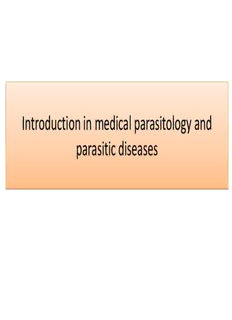
Introduction in medical parasitology and parasitic diseases PDF
Preview Introduction in medical parasitology and parasitic diseases
Introduction in medical parasitology and parasitic diseases Medical (human) parasitology • Human parasitology is the study of those organisms which parasitise humans • According to the very broad definition of parasitology, parasites should include the viruses, bacteria, fungi, protozoa and metazoa (multi-celled organisms) which infect their host species • However, for historical and other reasons the first three have been incorporated into the discipline of Microbiology • The biology of the parasite Medical parasitology has to investigate all aspects • The variation in life-cycle of the parasites of the following: • Methods of invasion of the host Agent s of diseases • Migration and maturation within the host Epidemiology • The effect of the parasite upon the host Pathogenesis and basic clinical • The host reaction and response to the signs parasite Laboratory diagnosis • Methods of escape from the host Antiparasitic drugs • Distribution of the parasite Prevention • Diagnosis of parasitic diseases • Treatment and prevention of the diseases Parasitic diseases → factors that led to the increasing frequency of some parasitic diseases and their spread • Increased mobility of the population • Popularity of the tropics and subtropics as vacation areas • Speed of transportation • Refugees from war-torn areas • Modification of environment by humans • “Global warming” • Illegal trade of animals • AIDS and patients under immunosuppression • Development of resistance to drugs (antimalarials) Geographic distribution factors (endemicity) • Presence of a suitable host • Habits of the host • Escape from the host • Favorable conditions outside of host • Economic and social conditions Geographic distribution of malaria Chloroquine resistance in malaria Geographic distribution of Echinococcus granulosus WHO – Priority diseases • Schistosomiasis Lymphatic filariasis • Malaria • Filariasis • Trypanosomiasis • Leishmaniasis • Leprosy (replaced by HIV/AIDS) The burden of some major parasitic infections Parasite Diseases No. people infected Deaths/yr Plasmodium malaria 273 million 1.12 million Soil transmitted helminths: 2 billion 200,000 • Roundworm (Ascaris) Pnemonitis, intestinal obstruction • Whipworm (Trichuris) • Bloody diarrhoea, rectal • Hookworm prolapse (Ancylostoma and Necator) Coughing, wheezing, abdominal pain and anaemia Schistosoma Renal tract and intestinal 200 million 15,000 disease Filariae Lymphatic filariasis and 120 million Not fatal but 40 million elephantiasis disfigured or incapacitated Trypanasoma cruzi Chagas disease 13 million 14,000 (cardiovascular) African trypanosomes African sleeping sickness 0.3 – 0.5 million 48,000 Leishamania Cutaneous, mucocutaneous 12 million; 2 million new 50,000 and visceral leishmaniasis cases/yr
Description: